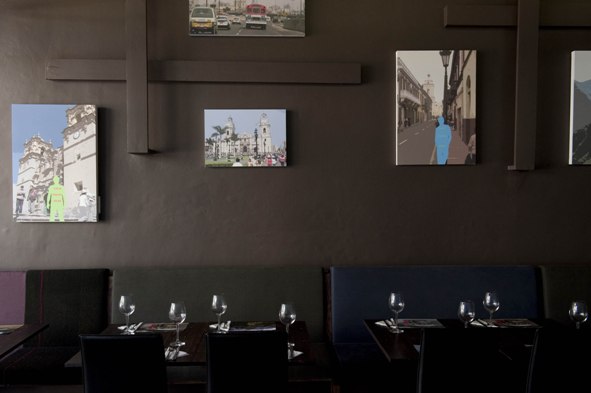Although hardly known in South Africa, Peruvian gastronomy is one of the great cuisines of the contemporary world. The immigrant rich story of the country has produced an innovative culinary tradition that blends unique indigenous ingredients with Spanish, African, Japanese and Chinese cookery. International chef Nobu Matsuhisa cut his teeth in Peru, and still dispenses his signature miso anticucho sauce.
Peru’s culinary annals are wonderfully summed up in the 18th century oil paintings you can see hanging in Lima and in Cuzco depicting the Last Supper with Christ and the disciples eating roast guinea pig.
Guinea pig or ‘cuy’ in the hands of a skilled chef is surprisingly good. The ultra-modern Map restaurant, a glass cube in the courtyard of Cuzco’s pre-Colombian art museum, specializes in nouveau Andean cuisine. Here I had three crispy guinea pig legs (they look like chicken drumsticks) roasted with a confit then flash fried and served on a bed of Andean corn purée, with a salad of Andean beans and dried fruit.
The name guinea pig actually comes from when the creatures were sold in Elizabethan England by the “Guinea-men” who plied the seas between South America, Guinea and the British Isles. Oddly enough, the taste is a cross between the dark, gaminess of guinea fowl and the fatty richness of pig.
Another carnivorous revelation in Peru was a tenderloin from one of those doe-eyed Alpacas (a kind of camelid like the more famous llama) with a crust of mustard grains and served with zucchini, papaya and mint at the Orient Express hotel outside the gates of Machu Picchu. A fine Alpaca carpaccio is also served on the train.
To give some idea of the inventiveness of the Peruvian chef, consider the following delights: in Lima, gazpacho with sautéed shrimp and tropical lucuma fruit (or ‘eggfruit’ – imagine a custard pumpkin); pork adobo (a hot Mexican marinade) slow roasted for 18 hours, breaded in Panko (Japanese bread crumbs) and briefly deep fried; on Lake Titicaca, trout with a range of exotic (for us) potatoes and cassava.
The potato was domesticated first in Peru, at least 8000 years ago. It is probably the country’s greatest gift to Western cookery; the spud now underpins national cuisines the world over since its introduction 400 years ago. On the rural markets you see potato filled sacks showing off a range of colours, from coal black to rose red, and a dazzling variety of shapes and sizes. There are hundreds of edible varieties. Potatoes are what NASA plans to take on future manned expeditions to Mars
The Peruvians also have a huge variety of corn, some black and even purple.
Several Cape Town restaurants have offered Peruvian ceviche, raw fish and seafood ‘cooked’ by the acid of limes and citrus. But the unpredictability of the flesh of our local fish seems to give chefs some trouble.
At celebrity chef Gastón Acurio’s trendy eatery in Mirafloes, I tried ‘erotic ceviche’ with oysters, sea urchin, scallop, black mangrove swamp clams, razor clams, aji chilli peppers and “leche de Tigre” (a shot glass of the astringent and spicy runoff after the fish is cured).
Cape Town is now lucky enough to have its first restaurant dedicated to Peruvian dining. Keenwä (the phonetic spelling of the grain quinoa) has not yet officially opened, but several early forays to it show great promise. Construction is underway to develop a pisco (white brandy from Muscat grapes) bar upstairs for pisco sours and cocktails.
Chef Arturo Melendez, originally from Lima, offers two ceviche, one with prawns and passion fruit (R70), the other with chilies and sweet potato (R65). Owner, German De La Melena, plans to incorporate clams in the future.
Quinoa (nicknamed Inca rice) is a delicate grain. Little known outside Peru a few years ago, packets are now popping up on our supermarket shelves. It looks a bit like couscous to start, but as it cooks it turns transparent and the spiral-like germ becomes visible. In Peru, I’ve had it in soups, risottos, and even cakes.
Keenwä serves a quinoa salad with vegetables, lime and honey mustard dressing (R60), quinoa croquettes with crab and langoustine (R60), and I happily recommend the quinoa and spinach cooked risotto style (R60).
The beef fillet (R135), on the rare side, is delicate and quite sweet, accompanied by a gooseberry relish as lovely as it is unusual, and Quinoa risotto.
Quinoa features in the desserts too, with crêpes (R35) made from quinoa flour, served with manjarblanco (a sauce of condensed milk and sugar) and flavoured with lucuma (imported in powdered form).
All the dishes are served on an assortment of pretty plates. They are simply garnished, usually with a salad leaf and a single black olive.
For potatoes the restaurant must rely on local varieties. South African grocery aisles of late have been offering a greater diversity of potatoes. I’ve found Lady Rosetta, French Ratte (or ‘asparges’), Shetland blacks and Pink Fir.
Traditional “causa” is a sort of mashed potato terrine, seasoned in a number of ways. In Peru I’ve had it with arracacha (an Andean cassava) stuffed with shrimps.
The causa limeña (R45) is layered with avocado and chicken-mayo. The mayonnaise itself is exceptional. The “papa a la huancaina” (R40), potatoes with a creamy feta cheese and chili sauce, has a pleasant, nutty taste.
Finally, I must suggest the alfajores. These sweet cookies, originally Arabic, found their way to Spain and on to a new perfection in Latin America. Take a bag of them home with you after sampling the fresh delights of Keenwä.
Keenwä, 50 Waterkant Street (at the Fan Walk foot bridge over Buitengracht Street). Tel: 021 419 2633


